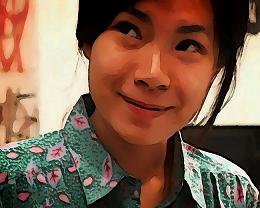April 29, 2007
IFFBoston: Year of the Fish
I recently got a manicure in New York City and remarked to a friend that every time I go into one of these salons I feel an air of oppression. There are teams of Asian women who barely speak English doing the fairly difficult labor of manicures and pedicures all for $8. How can they afford to live? How did they get here? Who is the scowling man who sits in the corner and watches the operations? Am I a jerk for participating in this situation? If I give her a big tip will she even get to keep it?
 These questions were fresh in my mind when watching Year of the Fish, a sort of fairy tale set among Chinese immigrants in New York’s Chinatown. In fact, the film is based on what is said to be the oldest known version of the Cinderella story, the ancient Chinese fable of Ye Xian. Shy new arrival Ye Xian lands in Chinatown expecting to work in a beauty salon to pay off her travel costs, only to find out that the salon in question specializes in “massage”, not beauty, and the evil shop madam and her bitter masseurs (step-daughters) hold her hostage to pay off her debts. After refusing to do massage, she is forced to scrub floors and toilets and cook for the “family” of prostitutes. There is a dashing prince (an American-born Chinese musician), a royal ball (Chinese New Year Party), and a fairy godmother (fortune-telling sweatshop-owning old chinese woman). It’s a clever premise, and I very much enjoyed the setting, one we rarely get to see close up in film, from the point of view of characters who actually live there rather than just visit for a drug deal and start shooting things and beating people up and crashing cars into wonton carts. I did ask the director why he didn’t shoot the film in Chinese, which would have added to the effect, but it’s understandable that he had certain constraints and this is after all a fairy tale–gritty realism is not a requirement. Then again, the massage-parlor storyline gets pretty graphic in places, and the grit of the Chinatown streets is certainly on full display, so it seems that if you open the door to this kind of mixture of reality and fantasy it’s fair to hope for the full effect.
These questions were fresh in my mind when watching Year of the Fish, a sort of fairy tale set among Chinese immigrants in New York’s Chinatown. In fact, the film is based on what is said to be the oldest known version of the Cinderella story, the ancient Chinese fable of Ye Xian. Shy new arrival Ye Xian lands in Chinatown expecting to work in a beauty salon to pay off her travel costs, only to find out that the salon in question specializes in “massage”, not beauty, and the evil shop madam and her bitter masseurs (step-daughters) hold her hostage to pay off her debts. After refusing to do massage, she is forced to scrub floors and toilets and cook for the “family” of prostitutes. There is a dashing prince (an American-born Chinese musician), a royal ball (Chinese New Year Party), and a fairy godmother (fortune-telling sweatshop-owning old chinese woman). It’s a clever premise, and I very much enjoyed the setting, one we rarely get to see close up in film, from the point of view of characters who actually live there rather than just visit for a drug deal and start shooting things and beating people up and crashing cars into wonton carts. I did ask the director why he didn’t shoot the film in Chinese, which would have added to the effect, but it’s understandable that he had certain constraints and this is after all a fairy tale–gritty realism is not a requirement. Then again, the massage-parlor storyline gets pretty graphic in places, and the grit of the Chinatown streets is certainly on full display, so it seems that if you open the door to this kind of mixture of reality and fantasy it’s fair to hope for the full effect.
The director also made the decision to rotoscope the entire film with a kind of painterly effect, which is a clever way to make digital video look less like … well, video. Which, in a fairy tale such as this, is appropriate. It’s odd though, after watching the effect for awhile you become accustomed to it and forget it’s there, and in some ways it loses its effect. I almost wished they had made the effect more dramatic in some way–some of the costuming looked very “costume-y”, which I think is the fault of video. Even with rotoscoping I just saw a guy with a big fake mustache. There were also clever painterly transitions and fades between scenes, all of which could have been kitschy in another film, but here were effective in keeping the film fantasy-like.
And there was absolutely no shakycam! Overall it’s an admirable film and I look forward to David Kaplan’s future projects.
 Filed by cynthia rockwell at 11:03 am under IFFBoston,Just Movies
Filed by cynthia rockwell at 11:03 am under IFFBoston,Just Movies
Comments Off on IFFBoston: Year of the Fish